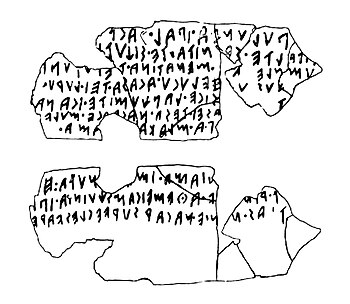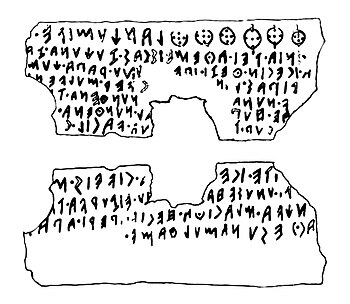Santa Marinella lead strips
The lead strip of Santa Marinella ( Italian Lamina plumbea di Santa Marinella ) is an Etruscan writing monument from the late 6th or early 5th century BC. The fragments of the lead strip are now in the Museo Nazionale Etrusco di Villa Giulia in Rome . The inscription on the lead strip is one of the longest ever found texts in Etruscan script .
description
The lead strip came from the period between 520 and 480 BC. And was about 2.7 cm wide. The original length of the lead strip is unknown as the ends on both sides and the middle section are missing. The largest remaining fragment is 6.9 cm long, 2.7 cm wide and 1 mm thick. The other fragments can be put together to form a block that is 6.6 cm long. The lead strip was written on both sides, with the letters getting smaller towards the end. In the first line the font size is 3 mm, in the following lines a maximum of 2 mm.
The size of the inscription and the lack of holes in the lead strips speak against a publicly posted text. The miniature inscription is extremely carefully executed and suggests that the content should only be legible for the initiated or for a deity himself. Therefore it could be the writing of a ritual, a sacrificial vow or an oracle.
Due to the nature of the damage, it can be assumed that the lead plate was arbitrarily destroyed. It could possibly have been broken through in the middle by a priestly official, whereby the board partially shattered due to the high pressure required. Thus, unauthorized persons could not gain knowledge of the content of the board. Perhaps the lead strip was considered the property of a deity and was therefore not melted down again, but rather thrown into a sacrificial shaft (Latin: favissa ).
inscription
The text that still exists today comprises about 80 words, 40 of which are fully legible. The other words are incomplete, only their beginning or end can be recognized. The individual words are usually separated from each other by a period, which was unusual at the time. In inscriptions from the 6th century BC Mostly two or three points were used as separators. The inscription is completely deciphered apart from ambiguities in a few letters, but the meaning of most of the words is still unknown.
| Fragment B |
Fragment A. |
According to the Etruscan writing habits, the inscription is written from right to left with mirror-inverted letters. The two fragments can be read line by line together. The text therefore begins in fragment A and leads to fragment B in every line. The beginning, the end and the middle part of each line are not preserved.
|
Fragment A.
|
Fragment B
|
The symbols on the first line probably represent Etruscan numerals . The first three could stand for 1000, the following three for 100. Perhaps it is a magical formula. The following LANCHUMITE, which recurs in line 5, probably represents an epithet , an epithet of a deity. LANCHUMITE could be related to the Greek word for lance ( λόγχη , Latin lancea ). The Etruscan goddess Menrva (Latin Minerva ) was often depicted with a lance. Perhaps she is called here as the lance goddess. The following IPAL could be the genitive form of IPA, wer, what, where .
ŚACNITALTE in line 2 probably has the same root as SACNI, sanctuary . The root word SAC denotes a sacred act or given. ŚACN in line 1 and ITALTE in line 2 could each be added to ŚACNITALTE, so that the repetition of the words gives the text a formulaic character. The word NUNTHENA, whose meaning is unknown, from line 5 is also repeated in line 6.
In line 4 Cver is almost certainly a votive offering . The following MULVENI could have the same root as MULUVENICE, he gave . MULVE from line 6 could be added to MULVENI again. NUNA in line 5 stands for consecration gift . The inscription refers to a gift that may have been or should be offered as a symbolic sacrifice of a supernatural power on the basis of a vow.
VACIL in line 7 stands for ritual , especially libation . Further words cannot be deduced beyond doubt from already translated inscriptions or using the combinatorial method. Some words such as THEZI, NUNTHENA, RAPA, ACASA and MULVENI can also be found on the Agramer mummy bandage and the Tabula Capuana . The meaning of the text today lies less in the barely understood content, but rather in the numerous new grammatical forms of Etruscan words.
Research history

The lead strip was found in 1964 or 1965 during the excavation of the sanctuary of Punta della Vipera. The excavations were directed by Mario Torelli . The sanctuary was dedicated to the Etruscan goddess Menrva and was located in the locality of Santa Marinella . In ancient times, the port of Punicum was located there, which probably goes back to the founding of the Etruscans. The nearest important Etruscan city was Caisra , today's Cerveteri . Punicum was probably the third port of Caisra next to Pyrgi and Alsium.
The temple had a square floor plan with a side length of 8 m and probably consisted only of a cella with columns on the front. He was born in the 4th century BC. Destroyed and rebuilt. In the 3rd century BC A remodeling took place and at the end of the 1st century BC The temple was finally destroyed. The fragments of the lead strip were found in a shaft belonging to the sanctuary.
Mario Torelli published a description of the find in the Archeologia Classica in 1966 . Massimo Pallottino added a short linguistic note in which he compared the words of the text with the already known Etruscan word roots. Mauro Cristofani published his deciphering of the inscription in the Studi Etruschi in 1967 . Ambros Josef Pfiffig presented an improved decipherment and an interpretation of the text in 1968. Karl Olzscha provided further additions in his Etruscan literary report from 1969, which was printed in the Glotta magazine. Since then, no generally accepted progress has been made as to the meaning of individual words or of the whole text.
literature
- Luisa Banti : Etruscan Cities and Their Culture. University of California Press, Berkeley / Los Angeles 1973, ISBN 052019105 , pp. 51, 196.
- Giuliano Bonfante , Larissa Bonfante : The Etruscan Language: An Introduction. Manchester University Press, Manchester 1983, new edition 2002, ISBN 0719055407 , p. 98.
- James Thomas Hooker (Ed.): Reading the Past: Ancient Writing from Cuneiform to the Alphabet . University of California Press, Berkeley 1990, ISBN 0520074319 , p. 346.
- Jean MacIntosh Turfa (Ed.): The Etruscan World. Routledge, New York 2013, ISBN 9781134055234 , pp. 463, 569.
Web links
Individual evidence
- ^ Mario Torelli, Massimo Pallottino: Terza campagna di scavi a Punta della Vipera e scoperta di una laminetta plumbea inscritta. Archeologia Classica, XVIII, 1966, pp. 283-299.
- ^ Mauro Cristofani: Rivista di epigrafia etrusca. In: Studi Etruschi. 35, 1967, p. 565.
- ^ Ambros Josef Pfiffig: About new Etruscan language material. In: language. 14, 1968, p. 149 ff.
- ↑ Ambros Josef Pfiffig: A sacrificial vow to the Etruscan Minerva, studies and materials for the interpretation of the lead strip by S. Marinella. Böhlau, Vienna 1968.
- ^ Karl Olzscha: Etruscan literature review. In: Glotta. 47, 1969, pp. 279-323.


